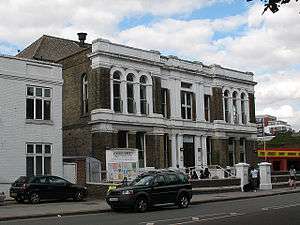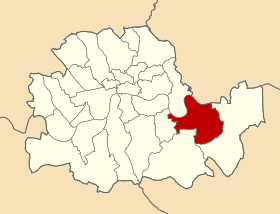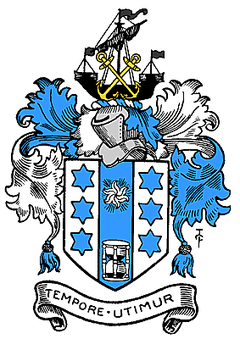Metropolitan Borough of Greenwich
The Metropolitan Borough of Greenwich was a metropolitan borough in the County of London between 1900 and 1965. It bordered the boroughs of Woolwich, Lewisham and Deptford and, across the River Thames, the borough of Poplar and the County Borough of West Ham in Essex. Within the area of the borough were the Royal Naval College (now the National Maritime Museum), the Royal Observatory and Greenwich Park.
| Greenwich | |
|---|---|
 Former Greenwich Town Hall (until 1939) | |
 Greenwich within the County of London | |
| History | |
| • Created | 1900 |
| • Abolished | 1965 |
| • Succeeded by | Royal Borough of Greenwich |
| Status | Metropolitan borough |
| Government | Greenwich Borough Council |
| • HQ | Town Hall, Greenwich High Road (until 1939); new Town Hall (from 1939) |
| • Motto | Tempore Utimur (We make use of time) |
 | |
The borough was abolished in 1965, and its area was merged with that of the borough of Woolwich to form the London Borough of Greenwich within the new ceremonial county of Greater London.
Formation and boundaries
The borough was formed from four civil parishes: Charlton-next-Woolwich, Deptford St Nicholas, Greenwich and Kidbrooke. In 1901 Charlton-next-Woolwich and Kidbrooke were merged to form Charlton and Kidbrooke.[1] In 1930 the remaining three civil parishes were combined into a single civil parish called Borough of Greenwich, which was conterminous with the metropolitan borough.[2]
Previous to the borough's formation it had been administered by two separate local bodies: Greenwich District Board of Works and Lee District Board of Works.[3]
Population and area
The borough covered 3,852 acres (15.6 km2). The population in each decennial census was:
Constituent parishes 1801–1899
| Year[4] | 1801 | 1811 | 1821 | 1831 | 1841 | 1851 | 1861 | 1871 | 1881 | 1891 |
|---|---|---|---|---|---|---|---|---|---|---|
| Population | 22,077 | 25,303 | 28,748 | 33,374 | 39,800 | 47,377 | 57,417 | 56,450 | 65,411 | 78,167 |
Metropolitan Borough 1900–1961
| Year | 1901 | 1911 | 1921 | 1931 | 1941 | 1951 | 1961 |
|---|---|---|---|---|---|---|---|
| Population | 95,780 | 95,968 | 100,450 | 100,924 | [5] | 89,846 | 85,546 |
Politics

The borough was divided into eight wards for elections: Charlton & Kidbrooke, Marsh, North West, North, South East, South, St Nicholas Deptford and West.[6][7]
Borough council
Metropolitan borough councils elections were held triennially. The first election to the borough council was held on 1 November 1900. The result was a majority for the pro-Conservative Moderates, who had 16 councillors elected. The opposition was formed by the Progressives with 8 seats.[8] At the next election in 1903 Moderates held control with the support of 2 Independent Conservative councillors.[9] By the time of the 1906 election, the Conservatives contested the elections throughout London under the Municipal Reform label. The Municipal Reformers held the council with 21 seats to 5 Progressives and 4 Independents.[10] They held the council at the 1909 and 1912 elections: 1909 saw the first Socialist councillor elected to the council.[11] Due to World War I, the next council election was not held until 1919. The Labour Party took control of the borough, with 20 seats to 10 for the Municipal Reform Party.[12] Three years later the position was reversed, with Municipal Reformers retaking control with 22 seats to Labour's 11.[13] At the 1925 election the Municipal Reform and Labour parties both took 15 seats, and the borough council was consequently under no overall control.[14] The same party composition was returned at the 1928 and 1931 elections.[15] Labour subsequently gained control, which they held at the 1934 election.[16] Labour held the borough at the 1937 election.[17] Elections were again suspended during the Second World War, the next contest being in 1945: Labour held the borough.[18] Elections to boroughs due in November 1948 were postponed to May 1949 to coincide with those for county councils. The Conservative Party contested the elections in the place of the Municipal Reformers. Labour held the council at this and all later elections to the metropolitan borough council, with the Conservatives forming the only other grouping.[19] The last election to the council was held on 10 May 1962, when Labour gained 29 seats to 6 for the Conservatives.[20]
Parliamentary constituency
A parliamentary borough of Greenwich had been formed by the Reform Act 1832. In 1918 the boundaries were realigned to correspond to the metropolitan borough.
Coat of arms
The borough council was granted a coat of arms by the College of Arms on 15 July 1903. The central band bearing an hour-glass represented the Greenwich Meridian and the surrounding stars the Royal Observatory. The crest above the shield was an ancient ship and crossed anchors, standing for the connections of Greenwich with the Royal Navy. The Latin motto was Tempore utimur or "We use time": a reference to Greenwich Mean Time.[21]
Some charges from these arms were taken over for the arms of the London Borough of Greenwich in 1965 and in 2012 for the new coat of arms of the Royal Borough of Greenwich.
Town Halls
West Greenwich House was built in 1876 and served as headquarters for the Greenwich District Board of Works before it was inherited by the new Borough Council in 1900. When built it had a dome and lantern above the parapet. It served as the Town Hall until 1939 after which it housed other council offices. Today it thrives as the West Greenwich Community and Arts Centre; the building was recently restored and refurbished.[22]
.jpg)
In 1939, a new and much larger Greenwich Town Hall and Borough Hall were built on the corner of Greenwich High Road and Royal Hill in the Art Deco style. When the Metropolitan Borough of Greenwich was merged into the London Borough of Greenwich in the 1960s, Woolwich Town Hall was used as the headquarters for the new larger borough instead. The Town Hall and Borough Hall buildings are now occupied by GSM London and a dance centre (Greenwich Dance) respectively.[23]
References
- "GB Historical GIS / University of Portsmouth, Charlton and Kidbrooke CP through time: Census tables with data for the Parish-level Unit". A Vision of Britain through Time. Retrieved 19 February 2015.
- "GB Historical GIS / University of Portsmouth, Borough of Greenwich CP through time: Census tables with data for the Parish-level Unit". A Vision of Britain through Time. Retrieved 19 February 2015.
- F A Youngs, Guide to the Local Administrative Units of England, Vol.I, London, 1979
- Statistical Abstract for London, 1901 (Vol. IV); Vision of Britain website
- The census was suspended for World War II
- Post Office London County Suburbs Directory, 1919. 1919. Retrieved 18 February 2015.
- Ordnance Survey 'County Series 3rd Edition' Map of London (1912–14) at 1:2500 scale. Accessed at https://www.old-maps.co.uk/
- The London borough elections, The Times, 3 November 1900
- London borough council elections, The Times 4 November 1903
- London borough council elections, The Times, 3 November 1906
- London borough council elections, The Times 3 November 1909; The London borough elections, The Times, 4 November 1912
- Borough council elections – Extensive Labour gains, The Times, 4 November 1919
- Labour rout in London, The Times, 3 November 1922
- The borough elections, a slight Labour advance, 4 November, The Times, 1925
- The municipal elections, The Times, 3 November 1928; The borough elections – Labour routed, The Times, 4 November 1931
- The municipal elections – more Labour gains in London, The Times, 3 November 1934
- The new London councils – state of parties, The Times, 3 November 1937
- The Municipal Elections – Results in London Boroughs, The Times, 3 November 1945
- The municipal elections, Changes in London boroughs, The Times, 9 May 1953; Labour gains in London poll, The Times, 12 May 1956; Borough elections – London results, The Times, 9 May 1959
- Election results in the boroughs, The Times, 11 May 1962
- A C Fox-Davies, The Book of Public Arms, 2nd edition, 1915; C W Scott-Giles, Civic Heraldry of England and Wales, 2nd edition 1953
- "About us". Greenwich West. Retrieved 24 April 2020.
- "Greenwich Town Hall". Manchester History. Retrieved 24 April 2020.
Further reading
- Robert Donald, ed. (1907). "London: Greenwich". Municipal Year Book of the United Kingdom for 1907. London: Edward Lloyd.